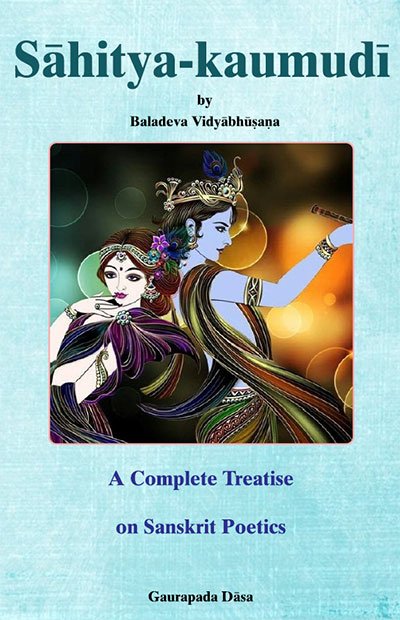Sahitya-kaumudi by Baladeva Vidyabhushana
by Gaurapada Dāsa | 2015 | 234,703 words
Baladeva Vidyabhusana’s Sahitya-kaumudi covers all aspects of poetical theory except the topic of dramaturgy. All the definitions of poetical concepts are taken from Mammata’s Kavya-prakasha, the most authoritative work on Sanskrit poetical rhetoric. Baladeva Vidyabhushana added the eleventh chapter, where he expounds additional ornaments from Visv...
Text 10.133
आगता यमुना-कुञ्जं हारिण्य् अपि विहारिणी ।
नित्यं वलय-युक्तापि राधा न वलयान्विता ॥
āgatā yamunā-kuñjaṃ hāriṇy api vihāriṇī |
nityaṃ valaya-yuktāpi rādhā na valayānvitā ||
Rādhā has come to the pleasure grove near the Yamunā. She sports (vihāriṇī) (or She has no necklace) although She has a necklace (hāriṇī). She has a new kind of combination of song, dance, and music (nava-laya-anvitā)[1] (or na valaya-anvitā, She has no bracelet) although She always has bracelets (valaya). (Bhakti-rasāmṛta-śeṣa 4.279)
evam ādy ukti-vaicitryeṇa śleṣato’pi virodho manyate.
A contradiction even on account of paronomasia is taken in consideration in this way because of the amazement of the wording.
Commentary:
The paronomasia in this verse is only a semblance of paronomasia (śleṣābhāsa) because the double meaning is not congruent either as a literal meaning or as an implied sense. The notion of śleṣābhāsa in the context of virodhābhāsa is fitting. According to Paṇḍita-rāja Jagannātha, the aforementioned ten categories of virodha are not really appealing, therefore virodha has two categories: pure and paronomastic. Jagannātha gives these examples: hita-kṛd apy ahita-kṛt, “Although he is hita-kṛt (a benefactor), he is ahita-kṛt (he cuts down enemies),”[2] and: agoddhārako’py nāgoddhārakaḥ, “Though He is agoddhāraka (He raises a mountain), He is not agoddhāraka (or He is nāgoddhāraka, He raises snakes).” Jagannātha says that if the word api (although) is used, then the śleṣa-mūla virodha is śābda (understood from the words), otherwise it is ārtha (understood by the force of the meanings, i.e. implied[3]).[4] Mammaṭa said that such a double meaning is a semblance of a double meaning (śleṣābhāsa), yet he did not include it in his poetical theory.[5]
Udbhaṭa gives two examples in one verse:
apārijāta-vārtāpi nandana-śrīr bhuvi sthitā |
abindu-sundarī nityaṃ galal-lāvaṇya-bindukā ||“She whose splendor was delightful (nandana-śrī) (or she had the splendor of Nandana Garden), even though talk about her did not involve pārijāta flowers, lived on Earth. She was beautiful like the moon reflected on water (abindu = ap-indu), and she constantly had trickling drops (bindu) of loveliness” (Kāvyālaṅkāra-sāra-saṅgraha 4.17).
Footnotes and references:
[1]:
[2]:
Hita means “benefit” and ahita means “enemy”. The first word kṛt is made with the verbal root [ḍu]kṛ[ñ] karaṇe (to do), after which the suffix t[uk] is added, by the rule: hrasvasya piti kṛti tuk (Aṣṭādhyāyī 6.1.71), and the second word kṛt is made with the verbal root kṛt[ī] chedane (to cut).
[3]:
[4]:
vastuto jāty-ādi-bhedānām ahṛdyatvāc chuddhatva-śleṣa-mūlatvābhyāṃ dvi-vidho jñeyaḥ. nanu, hita-kṛd apy ahita-kṛt, agoddhārako’py nāgoddhārakaḥ, ity-ādau virodhasya pratibhāmātram, śleṣa eva tv alaṅkāraḥ, tasya sva-viṣaye prāyaśaḥ sarvālaṅkārāpavādakatvād iti cet, kaviḥ śṛṇoti (this means Jagannātha only listens to, but does not accept, Udbhaṭa’s opinion regard the predominance of śleṣa). idaṃ tu bodhyam. yatrāpi-śabdādir virodhasya dyotakas tatra virodhaḥ śābdaḥ, anyatra tv ārtha iti tāvat prācāṃ siddhāntaḥ (Rasa-gaṅgādhara, KM p. 428). Jagannātha’s methodology of śleṣa is based on Udbhaṭa’s and Rudraṭa’s interpretation of śleṣa and is thus different from Mammaṭa’s methodology.
[5]:
na ca “abindu-sundarī nityaṃ galal-lāvaṇya-bindukā”[ Kāvyālaṅkāra-sāra-saṅgraha 4.17] ity-ādau virodha-pratibhotpatti-hetuḥ śleṣaḥ, api tu śleṣa-pratibhotpatti-hetur virodhaḥ. na hy atrārtha-dvaya-pratipādakaḥ śabda-śleṣaḥ, dvitīyārthasya pratibhāta-mātrasya prarohābhāvāt. na ca virodhābhāsa iva virodhaḥ śleṣābhāsaḥ śleṣaḥ. tad evam ādiṣu vākyeṣu śleṣa-pratibhotpattihetur alaṅkārāntaram eva. (Kāvya-prakāśa, verse 379 vṛtti)
